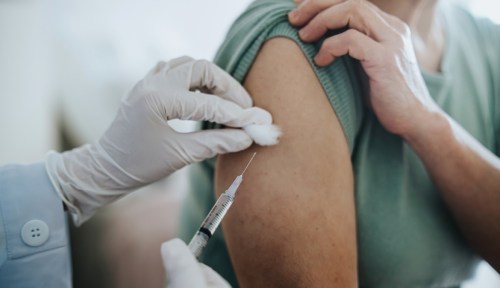I’m a 7-Time Egg Donor, and This Is What It’s Like To Donate Your Eggs
Learn what an egg donation process entails, from one woman who's donated her eggs seven times over five years.

I slowly begin to wake up, my mind and vision still a blur from the anesthesia. The bright lights and white curtains of my patient recovery area are coming into focus as I struggle to stay awake.
Experts in This Article
nurse practitioner at Poma Fertility in Kirkland, Washington
“The retrieval went smoothly with no complications, Alicia,” the nurse says to me. “And in even better news, you’ve officially set the record for the most eggs retrieved at our clinic. We got 79!”
As a first-time donor, I was clueless to the average eggs retrieved (typically 25 to 30, I would later learn). But setting a record certainly clicked with my foggy brain. I had successfully made it through my first donation and, as it turns out, I was a highly viable donor. In my bleary-eyed state, I had no idea that over the next few years, I would donate six more times.
I’m not sure exactly when I first considered donating my eggs. I vaguely remember seeing flyers looking for donors on campus when I was an undergrad at the University of Washington. I almost started the process when I was in my early 20s after coming across an ad for it on Craigslist. Weighed down by grad school loans to pay off and an insatiable thirst for travel, my curiosity was piqued by the financial benefits while I, in turn, could help a family grow. First time donors make between $5,000 and $7,000, depending on where they live, and the pay increases after each donation. But I had so many questions and insecurities about the process that I backed out. At the time, I wasn’t emotionally prepared to handle the idea of giving a part of myself to someone else and having biological children somewhere in the world.
Weighed down by grad school loans to pay off and an insatiable thirst for travel, my curiosity was piqued by the financial benefits while I, in turn, could help a family grow.
Yet over the next few years, I couldn’t shake the idea. Eventually, I found a reputable, family-run fertility company that helped assuage my uncertainties and take the step from curiosity to action. Some clinics treat donors like money-making machines, so I wanted to work with a smaller place that was rooted in donor relationships, and in thorough education about the process.
I was still apprehensive and only told my mom and a couple of close friends about my first donation. Donors have the choice of signing an NDA to keep all of the information private so that, in the future, the recipients and their children from your eggs can’t contact you. I signed all of these before my first donation, wanting to stay as private as possible.
Before I could actually donate, I had to undergo extensive tests—blood, DNA, psychology, and mental health, to name a few. This screening process ensures that the donor has healthy hormone levels and a clear health history, like no alarming genetic disorders and being a non-smoker.
Next up I created a donor profile, which helps prospective couples gauge if you’re a fit. I uploaded baby and toddler photos and filled in details like my physical attributes, hobbies, grades, and future goals. You can either be matched directly to a couple who chooses your eggs for a fresh donation, or your eggs can be retrieved, frozen, and stored in an egg bank until they’re chosen by a family down the line.
“Many intended parents mourn the loss of their own fertility and thus seek a donor that looks like them for family blending,” says nurse practitioner Linda Alexander, MS, NP-BC, of Poma Fertility in Washington. “After that, they seek women that are either like them academically, athletically, or possess the same creative arts talents that they either have or wish they had.”
Once you’ve been chosen, the total duration from first appointment to recovery is about two weeks, sometimes a bit longer depending on your body’s response to the two medications you’re given to stimulate the growth of your follicles.
As I sat in the nurse’s office watching her demonstrate how to inject myself with the medication using a foam belly, I thought, “There’s no way I can do that.” I locked myself in the bathroom on the first night, struggling to get the hang of the injections and terrified of hurting myself. Over time, this part has become second nature. The needles are short, thin, and, if used right, virtually painless aside from a tiny pinch.
I locked myself in the bathroom on the first night, struggling to get the hang of the injections and terrified of hurting myself.
The first week of the process is pretty easygoing. I give myself twice daily injections and make a few visits to the clinic for blood samples and ultrasounds. The changes in my body initially are minimal. I make sure to drink plenty of electrolytes and maintain a fiber- and protein-rich diet to help reduce bloating. At this point, donors need to refrain from sexual intercourse and drinking alcohol, Alexander says. “And after day five, I also recommend my donors to stop any form of heavy exercise,” she adds.
By week two, clinic visits are increased to every other day, and sometimes every day, and one more medication is added to the mix to prevent the follicles from prematurely ovulating. This is the point when I start to feel uncomfortable. As the eggs are growing in size and number, my abdomen area is increasingly tender. The couple of days before and after the retrieval are the most challenging.
“The ovaries enlarge due to the growing follicles,” says Alexander. “This can result in abdominal bloating and a sense of heaviness.”
Once the clinic deems your eggs ready for retrieval, you take one last injection, known as a trigger shot. A day and a half later, it’s go-time: You’re given a mild anesthesia through an IV before the procedure. “An ultrasound-guided needle identifies follicles and aspirates fluid from them and finds the eggs,” says Alexander. “It’s sort of like a blood draw through the vaginal area.”
I’ve found I always need to plan a day or two of rest afterwards. Between the anesthesia and the soreness from the retrieval, I stay in bed for most of the day. The bloating gets worse before it gets better, walking is uncomfortable, and my energy levels remain low. Severe side effects are uncommon, though donors do run risks of infection, bleeding, and ovarian hyperstimulation in the process. Most of mine were easy recoveries except the first, in which I had extreme bloating as a result of the unusually high number of eggs that were retrieved. And on the sixth donation, I experienced blinding pain shooting up my shoulder and back every time I tried to move, which I learned was from fluid moving up from my abdominal cavity. Although I was terrified, the symptoms subsided within about 48 hours.
“Prospective donors also may worry about the myth that donation compromises future fertility,” says Alexander. “The body normally recruits a certain number of follicles every cycle and only one follicle becomes the dominant follicle. The remaining follicles wither away during a process called atresia and are no longer available. This process is repeated each month. During the donor IVF process, it is only this month’s recruited follicles that are matured for donation. It is not possible to recruit future follicles, meaning your future fertility isn’t impacted.”
While I remained very private during my first couple of donations, I’ve now become transparent about it. I enjoy talking about the experience and am open to connecting with recipients down the line, if they’re interested. I also find a sense of empowerment in donating. Through this process, I’ve learned a wealth of knowledge about women’s health and fertility, more about my own health and family genetics, and that I have high fertility should I ever decide to have children of my own one day.
I also find a sense of empowerment in donating.
I’ve now donated seven times over the course of about five years. And that might be it for me. Recently, clinics have tightened restrictions and capped the limit at six donations. This is partly for the sake of donors’ health and partly to limit the number of eggs from one person available in a given area. But if the opportunity presents itself, I would donate one final time to complete this unexpected chapter of my life.
Earlier this year, I received a letter from a couple who had a baby from one of my donations. They described in detail their own journey to becoming parents, their gratitude for my gift, and shared with me details like the red hair and the blue eyes of the baby boy who was born from my egg. I had long put out of my head what happened after I donated (something that initially consumed my thoughts and deterred me from donating all those years ago). This humbling letter brought back into perspective the full impact of my donation: the ability to help hopeful parents become a family. In this case, it was a gay couple who otherwise wouldn’t have a biological child of their own. It’s an experience that is at once intangible and irreplaceable.
Sign Up for Our Daily Newsletter
Get all the latest in wellness, trends, food, fitness, beauty, and more delivered right to your inbox.
Got it, you've been added to our email list.










